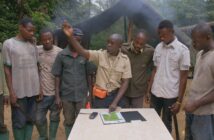Today is a big day for lions, as the U.S. Fish and Wildlife Service has extended protection to Africa’s lions following the aftermath of recent stories of trophy hunting and the decline of the overall species as a whole. In a statement, Dr. Goodall said “I welcome the news that the U.S. Fish and Wildlife Service will be providing extra protection for the African lion by changing their status from “Vulnerable” to “Threatened” (except in some parts of its range, including West Africa, where it is classified as “endangered” as it is in Asia).
Across most of Africa, lion populations have declined by 60 percent since 1993 and there are fewer than 30,000 lions left today. This decline is due to habitat loss, loss of prey, human/wildlife conflict, unsustainable trophy hunting and the increasing international trade in lion bones for traditional medicine in both Africa and Asia.
The Threatened Species listing will help ensure that the United States is not contributing to the further decline of this iconic species by prohibiting the import of lion trophies and the commercial trade in lion parts unless such activity can be shown to enhance the survival of the species in the wild.”
Lion Tales
Lions have been in the news recently. When Cecil, the well known and loved black maned lion, was shot by a trophy hunting American dentist with a crossbow, there was an international outcry and Palmer went into hiding. But Sabrina Corgatelli, another American who was on a hunting safari at the time, continued to post photos of herself grinning beside a lion and other dead animals. As a result of these and other similar stories more people became aware that lion numbers have plummeted throughout much of Africa. This decline is due to habitat loss, diminished number of prey animals, and hunting. Trophy hunting is not significant with regard to actual numbers of lions killed – but trophy hunters go for the handsome males with the most beautiful manes – the very individuals most valuable for siring cubs and the future health of the population.
Martyr for a Cause
So why does this shocking story appear on my Good For All News page? Because Cecil was a well known, well loved and an extremely good looking lion, his murder created an international uproar. Thousands of people protested. The dentist went into hiding. The Zambian authorities are attempting to extradite him to face charges of illegal killing (Cecil was lured from the Reserve where he was safe). Many of the major international airlines have banned the transport of animal trophies, and others are expected to follow suite. And many people who never gave trophy hunting much thought, are now keenly aware of what is going on.
In other words, Cecil has become a martyr for a cause, and his killing may prevent other magnificent lions – and rhinos, elephants, hippos, leopards, giraffes, antelopes and so on – from sharing the same fate.
My First Encounter with a Lion
I will never forget my first sighting of a wild lion. Today lions are listed as threatened, but this was far from the case when I arrived in Africa in 1957. Louis and Mary Leakey invited me to take part in a three month ‘dig’ at Olduvai Gorge, Tanzania. The Leakey’s were sure that the “Olduvan pebbles” were bolus stones, used by early hominids although, at that time, only the fossilized bones of a variety of prehistoric animals had been found – caevotherium, the forerunner of the modern giraffe, giant warthogs and baboons the size of gorillas. Gillian (another young girl who worked at the museum with me) and I had been invited to join a three month fossil hunting expedition that summer. With us were two dalmatian dogs, Bottom Biter and Toots. Toots is the champion of all breeds of Kenya, and Mary Leakey’s prized companion. Their job was to keep watch for predators when the team was crouched on all fours, searching for fossils. (Apparently, on one occasion, Bottom Biter earned his name by nipping the rear end of Mary when he sensed a nearby lion!)
After the hard day’s work Gillian and I were allowed to walk out on the plains – and Mary asked that we would take the dogs with us. On this memorable evening, as we walked along an animal trail on the floor of the gorge, a very small mouse ran across in front of us and took refuge in the vegetation below a thorn tree. The two dogs, thrilled, rushed after it.
I sensed something behind me – and looking round saw, about 300 yards away, a young male lion, probably around 2 years old, full grown, but with his mane just sprouting from his shoulders. He was standing and staring at us. He had almost certainly never seen white women, and he was curious. I had no sense of fear – just excitement. The dogs were reluctant to abandon their mouse hunt but eventually we grabbed them and, after securing them with Gillian’s belt and some string I carried in my pocket, we moved away. Fortunately the dogs never saw the lion, though he followed for some distance, only stopping when we climbed up the side of the gorge onto the open plain.
Imagine my dismay when Gillian removed her belt and Toots, champion of all breeds of Kenya, rushed back to continue her mouse hunt. We called and called. No response. I was about to climb back into the gorge – I would rather have faced the lion (who had moved out of sight) than Mary Leakey’s fury had we lost her beloved dog to a lion – when fortunately Toots, panting and mouse-less, finally returned.
It was a memorable day in more ways than one, for I truly believe that it was that evening, after I recounted our adventure around the campfire, that Louis decided I was the person he had been searching for to go study chimpanzees.
Lion Reappears in Gabon after no Sightings for 20 years.
And now for some extraordinarily good news from Gabon where camera traps have recorded a male lion wandering along an elephant path in the southeastern part of the country in the region of the Batéké Plateau. Lions had been thought extinct in this area for 20 years. And you will be interested to know that the discovery occurred as part of a chimpanzee study of the Batéké Plateau National Park undertaken by the Max Planck Institute of Evolutionary Anthropology and the Aspinall Foundation. For footage of the Gabon lion click here.
As a result of this discovery, several organizations including Panthera (a big cat conservation group), the Max Planck Institute of Evolutionary Anthropology, the Aspinall Foundation and Gabon’s National Park Authority are working together to monitor this lion’s activity and hopefully find additional lions. According to Panthera’s Lion Program Survey Coordinator, Dr. Philip Henschel, “This footage is truly unexpected, and yet wonderful proof that life for the lions of Gabon and the region remains a possibility.”.
Be sure to check back later this week for part two of Jane’s story, where she will further the conversation about animal/human conflict and how the lion guardianship program in Africa is making strides to project these beautiful creatures.






